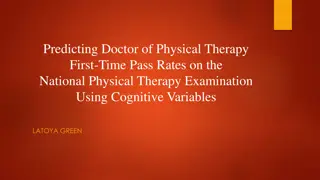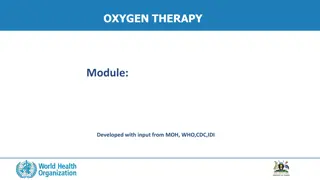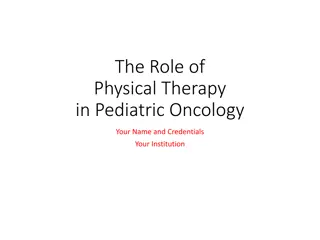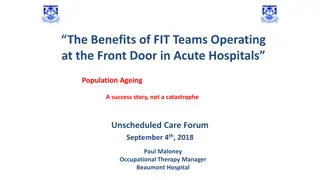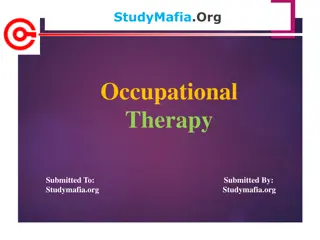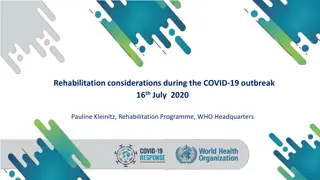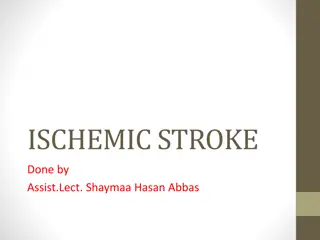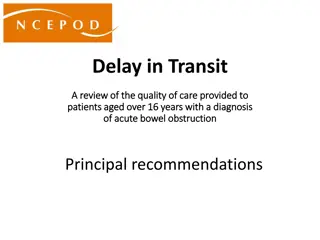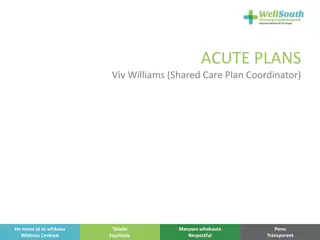Improving Efficiency in Acute Care Physical Therapy: A Case Study
Northwestern Memorial Hospital implemented a multidisciplinary approach to reduce unskilled consults in physical and occupational therapy, enhancing patient care through targeted education and collaboration among healthcare professionals. The initiative involved defining unskilled consults, providing training sessions, establishing an interdisciplinary focus group, addressing root causes, and incorporating mobility discussions in patient care to streamline the referral process and optimize therapy utilization.
Download Presentation

Please find below an Image/Link to download the presentation.
The content on the website is provided AS IS for your information and personal use only. It may not be sold, licensed, or shared on other websites without obtaining consent from the author. Download presentation by click this link. If you encounter any issues during the download, it is possible that the publisher has removed the file from their server.
E N D
Presentation Transcript
Improving Efficiency in Utilization of Acute Care Physical Therapy Justin Dreessen, SPT University of North Carolina Chapel Hill
Objectives Define unskilled consult Recognize the opportunity to improve efficiency in acute care PT Understand the importance of interdisciplinary education and collaboration Take away tangible action steps to implement in practice to improve patient care
Improvement of Physical and Occupational Therapy Referral Process to Reduce Unskilled Consults1 Northwestern Memorial Hospital houses 894 beds w/ 34 PT/PTAs and 26 OTs Baseline data collected for 9 months showed PT and OT services consulted 14.5% of the time for unskilled therapy needs Multidisciplinary education intervention to reduce unskilled consults Unskilled consults defined and categorized as: Patient not medically appropriate to participate Patient not cognitively intact to actively participate in a therapeutic manner Patient demonstrating baseline level of functional mobility with nursing/medical team Patient requiring next level of care to address musculoskeletal issue in the outpatient setting
Methods1 Team of PTs and OTs covering 4 adult inpatient general medicine units Trained through one-time meeting on how to define each category, how to select these categories in the EMR, and how the data would be collected One follow-up education session and one recurring monthly meeting, which included 3 case scenarios
Methods1 Established interdisciplinary focus group, including 2 PTs, 1 OT, 2 MDs, 2 RNs, 2 attending (discharge) RNs, and a SW Feedback from providers regarding culture of mobility, role of PT/OT, skilled versus unskilled PT/OT consults, and strategies to reduce unskilled consults Incorporate mobility and ADL discussion for each patient in IDR What is the expectation of mobility/ADL performance, and by whom/how should this be communicated? 4 likely root causes to unskilled consults: Orders placed preemptively by hospitalists Hospitalists unsure of mobility level before consulting PT/OT Mobility/ADL expectation as a priority in IDR is not high RN unsure of mobility or ADL level
Methods1 PT/OT attended IDR 3 days per week and led discussion around mobility and ADL performance and discharge recommendations Unit clinic coordinator and hospitalists led IDR meetings and were tasked to educate their department to consistently promote discussion of mobility and ADL performance during IDR Unit clinic coordinator provided with and educated on using handout to stimulate mobility/ADL discussion
Results1 PT and OT collectively consulted for unskilled therapy needs 14.5% of the time down to 3.05% Patient at baseline level of function was most likely type of unskilled consult preintervention Interdisciplinary approach using IDR can reduce unskilled consults Total PT/OT consults during intervention period = 734 % reduction in unskilled consults = 10.55% 734 x 10.55% = 78 less PT/OT consults over 8 weeks across 3 therapists
Efficiency Breakdown1 Total PT/OT consults during intervention period (734) % reduction in unskilled consults (10.55%) = number of skilled PT/OT consults culled by reducing unskilled consults (78) Divided among 3 PTs, the consult volume/week during intervention period = 30.5 consults/week (734/8 weeks = 91.75/3 therapists = 30.5) Using the % reduction in unskilled consults (10.55%), after the intervention period = 27.3 consults/week (734 78 = 656/8 weeks = 82/3 therapists = 27.3) The consult volume reduction from 30.5 to 27.3 (3.2), creates 19.2 weeks of PT time/year, or 0.37 FTE (19.2/52) to respond to skilled consults.
Discussion1 Flexibility to respond to same-day orders for other patients with skilled therapy need for evaluation/treatment Improved communication within interdisciplinary team opening discussion for each discipline s role in patient mobility while hospitalized PT/OT role in education was objectifying what constituted as a skilled versus unskilled consult Mobility and ADL discussions were more productive when hospitalists set expectation for daily mobility with nursing staff Developed culture of mobility and assisted in determining the right provider to perform tasks like walking and toileting
Defining Potential Overutilization of Physical Therapy Consults on Hospital Medicine Services2 During hospitalization, patients spend 87% to 100% of their time in bed, which is a key contributor to hospital-associated disability (HAD) Early mobilization and throughout hospitalization to prevent HAD typically falls on shoulders of PT PTs are a constrained resource in most inpatient settings Aimed to assess potential overutilization of PT consults on direct care hospital medicine services using validated AM-PAC cutoffs
Methods2 Retrospective cohort of admissions throughout one year on all direct care hospital medicine services at the University of Chicago Medical Center (UC) General medicine, oncology, transplant (renal, lung, and liver), cardiology, and cirrhotic populations at the medical-surgical and telemetry level of care Patients hospitalized for longer than 48 hours Exclusion: patients who left AMA; died; d/c to hospice, another hospital, or an inpatient psychiatric facility; or received no PT referral during admission Age, sex, admission and d/c dates, admission and d/c AM-PAC scores, and discharge disposition obtained At UC, nursing staff assess and documents AM-PAC mobility scores for each patient at the time of admission and every nursing shift thereafter
Methods2 Primary outcome: potential overutilization Secondary outcome: d/c disposition and change in mobility Predictors: AM-PAC score, age, and sex AM-PAC score of 42.9 (raw score, 17) = cutoff for predicting d/c to home Physical therapy consults potentially inappropriate : patients with admission AM- PAC scores >43.63 (raw score, 18) who were d/c home At UC, nursing staff independently mobilize patients with AM-PAC scores >18 D/c home: going home with no additional needs or services, going home with outpatient PT, or going home with home health PT None of these require inpatient PT assessment for order to be placed D/c to post-acute care: long-term acute care, SNF, subacute rehab facility, or acute rehab facility Loss of mobility calculate as: d/c AM-PAC admission AM-PAC
Results2 3592 admissions with PT consults (58% of all admissions) Mean age: 66.3 years 48% female Mean admission AM-PAC score: 43.9 (SD, 11.1) Mean admission d/c AM-PAC: 46.8 (SD, 10.8) 38% of PT consults for patients with AM-PAC score >43.63 who were d/c to home and deemed potential overutilization 89% of patients with AM-PAC >43.63 d/c home compared to 55% 43.63 Most of the 11% with high mobility not d/c home due to personal/social or medical needs Only 16% of the 11% (n = 23) experienced deconditioning necessitating PT consult during hospitalization 79% of patients younger than 65 d/c home compared to 63% older than 65 Mean delta AM-PAC: AM-PAC > 43.63 on admission = -0.41, AM-PAC on admission 43.63 = +5.69 AM-APC > 43.63 and age younger than 65 associated with increased odds to d/c to home
Discussion2 Limitations: Did not consider whether PT contributed to patients ability to return home after d/c Did not consider d/c diagnosis PTs may be unnecessarily consulted on direct care hospitalist services as much as 38% of the time based on AM-PAC score Patients admitted with high mobility by AM-PAC score are more than 5 times as likely to d/c to home When admitted with high AM-PAC scores, patients had very little change in mobility during hospitalization, whereas patients with low AM-PAC scores gained mobility during hospitalization Significant benefit of PT in low AM-PAC patients Appropriate allocation of PT has the potential to improve outcomes from the patient to the payor level Identifying patients who will benefit from skilled physical therapy at time of admission can help prevent disability and institutionalization and shorten length of stay PT consult may be necessary later in hospitalization for reasons other than mobility Decreasing PT referrals for low-risk patients can increase amount of time spent rehabilitating at-risk patients
Development of a Unique Triage System for Acute Care Physical Therapy and Occupational Therapy Services3 Purpose: develop a triage tool to improve patient access to medically necessary therapy services Reduce the following: inefficient use of resources, potential liability risks for patients not seen, and staff dissatisfaction from burnout Triage tool and decision tree developed to determine which patients referred to therapists for acute care therapy required skilled services Triage tool examined therapy referrals for patients from 2 large academic hospitals (1,157 beds with 38 PTs/8 PTAs/33 OTs/9 COTAs/295-430 caseload, 794 beds with 10 PTs/3 PTAs/3 OTs/70-90 caseload) 6 criteria used to determine which evaluations should be cancelled
Methods3 Rehab Innovation and Optimization Team (RIOT) 4 therapist managers who oversee both PT and OT along with a physiatrist from a large physical medicine and rehab department Enrolled in an intense education and training program on quality improvement methods Address lack of consistency in triage of referrals to acute care PT/OT and reducing volume of referrals that did not meet Centers for Medicare and Medicaid Services standards for medical necessity in acute care settings Reviewed 246 medical records Exclusion criteria: referrals from orthopedics, physiatry, pediatrics, psychiatry, and pulmonology; referrals for hand therapy, wound or lymphedema management, and after selective denervation for torticollis
Methods3 Triage tool created with survey format 2 therapist leaders screened all referrals that met inclusion criteria (N=170) No consults cancelled or deferred in this beta period Recommendation about appropriateness of therapy services made but not communicated to evaluating therapist 2 additional project team members reviewed evaluating therapist s documentation because all consults were allowed to progress to caseload Triage tool correctly recommended cancellation 100% of the time Once triage tool validated, process implemented at both hospitals Took RIOT team 3-5 minutes to review EMR to triage referral Education presented to referring providers, nurse managers, and social workers
Outcomes3 Systematic triage system reduced number of therapy evaluations that were not appropriate by 29% Improvement in availability of therapy services for patients who required skilled care Average number of patients per therapist per workday decreased from 18.9 to 12.1 and from 15.1 to 12.8 in the 2 hospitals Therapist productivity and net revenue improved
Toward a Common Language for Measuring Patient Mobility in the Hospital4 Johns Hopkins Hospital Objective: Evaluate the reliability and minimal detectable change of AM-PAC IMSF and JH-HLM when completed by nurses and PTs and to evaluate the construct validity of both measures when used by nurses Test-retest reliability and the interrater reliability of AM-PAC IMSF and JH-HLM for inpatients in the neuroscience department (n=118) were evaluated Each participant scored twice by a team of 2 nurses and 1 PT 4 PTs and 8 nurses participated in reliability testing Construct validity evaluated via assessment of convergent validity with other measures of function (grip strength, Katz Activities of Daily Living Scale, 2- minute walk test, 5-times sit-to-stand test) used by 5 nurses
Results4 AM-PAC IMSF test-retest reliability values for PTs = 0.91 and nurses = 0.97 JH-HLM test-retest reliability values for PTs = 0.94 and nurses = 0.95 Interrater reliability values between PTs and nurses 0.96 for AM-PAC IMSF 0.99 for JH-HLM The AM-PAC IMSF and JH-HLM had excellent interrater reliability and test- retest reliability for both PTs and nurses AM-PAC IMSF and JH-HLM measured constructs of patient mobility and physical functioning
Cases 25 y.o. admitted with join pain/swelling; pain resolved; independent 37 y.o. with hypoglycemia; independent 46 y.o. with renal failure; independent Pt with possible PNA; independent Independent pt who was d/c from PT with home recommendation; social issues and wound care preventing d/c; new consult for pre-cert to SNF/new d/c recommendation
Therapy Consult Therapy needs Yes Consult pre-op / med work up evolving/pending Educate / screen / attempt written No no has needs no facility has no needs new baseline Immobility harm risk no needs Complex needs Dementia / guarding has needs could go home has needs medically labile has needs slow progress has needs D/C keeps changing needs / refuses needs / refuses Risk / Harm No Yes Triage 3 vs 4 For Now Call Kerry
Takeaways Focus on the difference in level of function from prior to current Begin with far ends of the curve (completely independent/dependent) Give mobile patients the tools to stay independent in hospital, and take them off caseload (education, HEP, etc.) Screen rather than conduct a consult Facilitate mobility conversation with interdisciplinary members of care team Management is working on implementing AM-PAC system with nursing Evidence supports offloading some patients, but we have nowhere to funnel them currently
References 1. Bednarczyk M, Pritchard K, Barquin W, Beyer A, Stankiewicz C. Improvement of physical and occupational therapy referral process to reduce unskilled consults. J Acute Care Phys Ther. 2020;11(2):54-58. doi:10.1097/JAT.0000000000000115 2. Martinez M, Cerasale M, Baig M, et al. Defining potential overutilization of physical therapy consults on hospital medicine services. J Hosp Med. Published online August 18, 2021. doi:10.12788/jhm.3673 3. Hobbs JA, Boysen JF, McGarry KA, Thompson JM, Nordrum JT. Development of a unique triage system for acute care physical therapy and occupational therapy services: an administrative case report. Phys Ther. 2010;90(10):1519-1529. doi:10.2522/ptj.20090166 4. Hoyer EH, Young DL, Klein LM, et al. Toward a common language for measuring patient mobility in the hospital: reliability and construct validity of interprofessional mobility measures. Phys Ther. 2018;98(2):133-142. doi:10.1093/ptj/pzx110
Questions? https://forms.gle/J eY3PCnTAm55Yg4J8





